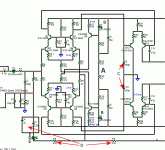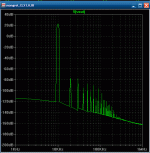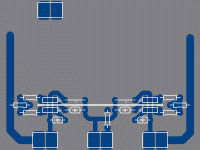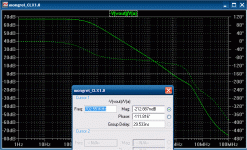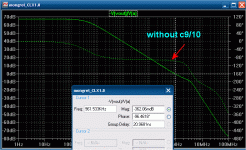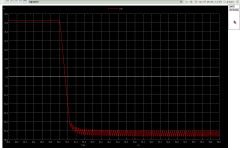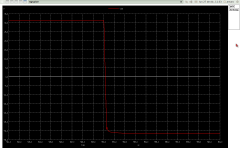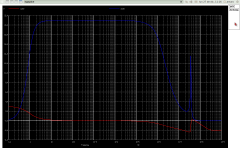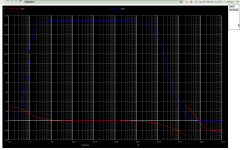nice to see you back OS.. 🙂
Nice to be back , hope I won't get "trolled again". Keep a real clean house and a better plan for just that occasion. The Sinbin was a very productive place , a bottle of HCL (more amps) in one hand and some "shine" in the other. 😀
OS
Hi OS,
I am glad to see you back. I enjoy your productivity, insite, experimentation and pragmatism. I am with c2cthomas in my desire to build one of your amplifiers.
I think you got a raw deal.
Mark
I am glad to see you back. I enjoy your productivity, insite, experimentation and pragmatism. I am with c2cthomas in my desire to build one of your amplifiers.
I think you got a raw deal.
Mark
Totally agree, you definately got the raw deal here.
Cheers for the board layout, its hard to believe that there will be such dramatic improvements over my current GX. Can't wait to here it.
I have nearly finished my BX boards to try as well, just waiting on a some transistors to arrive.
My next project is to make some speakers worthy of these amps, I just noticed that my woofers have started to crack up and have been looking for an excuse to attempt some diy. I haven't decided which way to go yet, any thoughts are welcome, probably 2 way tl floor standers but open to any thoughts.
Cheers for the board layout, its hard to believe that there will be such dramatic improvements over my current GX. Can't wait to here it.
I have nearly finished my BX boards to try as well, just waiting on a some transistors to arrive.
My next project is to make some speakers worthy of these amps, I just noticed that my woofers have started to crack up and have been looking for an excuse to attempt some diy. I haven't decided which way to go yet, any thoughts are welcome, probably 2 way tl floor standers but open to any thoughts.
Totally agree, you definately got the raw deal here.
Cheers for the board layout, its hard to believe that there will be such dramatic improvements over my current GX. Can't wait to here it.
I have nearly finished my BX boards to try as well, just waiting on a some transistors to arrive.
My next project is to make some speakers worthy of these amps, I just noticed that my woofers have started to crack up and have been looking for an excuse to attempt some diy. I haven't decided which way to go yet, any thoughts are welcome, probably 2 way tl floor standers but open to any thoughts.
I need speakers , too 😱 The PB250 is deserving of some nice 3- way 12" sealed units.
OS
It's good to see you back OS!!! 😀😀😀
I took it like a man , ghosts of former inmates (sinbin) tellin ' their stories. 😀 I am MUCH wiser to the "ways" .. now.
Happy new year !!!
OS
Pete, I know you want a 12". How about something like this to 'tide you over? It's a Genelec/Peerless 10" under an NHT mid and the Vifa XT25. If you really need more woof, I guess 2-10's could be arranged...
...did you learn the word's to "Alice's Restaurant" while you were gone? In there with all those ?😱? ? and sent there for litter'n?, and creatin' public nuisance?
? and sent there for litter'n?, and creatin' public nuisance?
I'm glad we didn't have to send the dogs to find you...

...did you learn the word's to "Alice's Restaurant" while you were gone? In there with all those ?😱?
 ? and sent there for litter'n?, and creatin' public nuisance?
? and sent there for litter'n?, and creatin' public nuisance?I'm glad we didn't have to send the dogs to find you...
Last edited:
Pete, I know you want a 12". How about something like this to 'tide you over? It's a Genelec/Peerless 10" under an NHT mid and the Vifa XT25. If you really need more woof, I guess 2-10's could be arranged...
...did you learn the word's to "Alice's Restaurant" while you were gone? In there with all those ?😱?? and sent there for litter'n?, and creatin' public nuisance?
I'm glad we didn't have to send the dogs to find you...
I was considering 2 - 10's , buy 2 (4) midpriced 4R's from MCM (MCM select) run them in series. Real nice woodworking, man (I am a pro trim carpenter as well).
On to amps , I must concede that Artu's VAS (I am not sure it is his ?? ) and the design "RULES" . AX might have lower PPM , but the CLX (below 1) has the best FFT (below 2) and holds it to 100k (125+ V/us slew as well). On the
Schema below " A" ... should I reference to earth or the rails ? "B" should I use (keep) the
 merry LED's as current sources or upgrade to my usual 2 transistor deal. "C" "backend" compensation caps , with them a slight lack of phase margin at UG , without them all is well. 😕😕
merry LED's as current sources or upgrade to my usual 2 transistor deal. "C" "backend" compensation caps , with them a slight lack of phase margin at UG , without them all is well. 😕😕"D" - I use standard full AC coupled DC blocking/input , a DC servo will have little effect. I even subbed out the IPS PNP's with a known mismatched model, offset stayed under 10mV. 🙂
Artu's design has a super low impedance NFB network and fully DC coupled , ABSOLUTELY needs a DC servo circuit . A 14 transistor voltage board will not be a "brain breaker"(below 3) , still DIY friendly - super symmetrical . C2C , this may be the "ONE" for you. (8PPM@ 100-5k / 12PPM@10-20k , and 50ppm max@even 50-100k !!) 😱
Attachments
Last edited:
C2C , this may be the "ONE" for you. (8PPM@ 100-5k / 12PPM@10-20k , and 50ppm max@even 50-100k !!) 😱
I'm in no rush - pretty much all our spare $$$ goes to supporting our 17 y/o granddaughter we have custody of. She's chaffing at the bit to move in with her BF when she hits 18 and that will free up some $$$$ to play around with - provided that SWMBO doesn't beat me to it. Rats - forget that thought!!!! There is NO WAY I can spend money faster than she can - hmmmmmm. The main thing I need to focus on is a good music server source and DAC's - then bi-amp or tri-amps with active xovers for da speakers. Until I get a good source up and running everything else can wait 'cause things are good enough fer now. 😉
When I get back to doing the amp thing it will be one stereo set for the highs (say 25 to 50 watts) a set for the mids (maybe the same - perhaps more depending on the drivers) and some plate amps for the bass units. For sure will use my AMT1's above 6kHz and some big Eminence unit down low - the midrange remains a mystery right now but the B&G 10 has my eye.
They look great Ed. How do they sound?Pete, I know you want a 12". How about something like this to 'tide you over? It's a Genelec/Peerless 10" under an NHT mid and the Vifa XT25. If you really need more woof, I guess 2-10's could be arranged...
...did you learn the word's to "Alice's Restaurant" while you were gone? In there with all those ?😱?? and sent there for litter'n?, and creatin' public nuisance?
I'm glad we didn't have to send the dogs to find you...

Hey OS, welcome back. I hope it all worked out.
Shouldn't C9 and C10 be referenced to the negative rail? As it is they are adding interference between the rails and ground.
- keantoken
Shouldn't C9 and C10 be referenced to the negative rail? As it is they are adding interference between the rails and ground.
- keantoken
Hey OS, welcome back. I hope it all worked out.
Shouldn't C9 and C10 be referenced to the negative rail? As it is they are adding interference between the rails and ground.
- keantoken
Those (C9/10) don't decouple. I wan't artu's opinion on their purpose. What I did find is that they DO roll off HF response (I think artu stated this). They also decrease phase margin( below 1/2). I am covering all bases on the associated board , one can just omit c9/10 or add lead compensation to "fix" it. 😀
I must also see if they (C9/10) increase PSRR of the voltage stage. Regardless , 10X better than either the leach or symasym voltage stages and super stable w/either compensation scheme.
OS
Attachments
I thought they may be a way of decoupling Cob/Miller effects, but they are on the wrong side of the VAS for that. If not for open-loop phase-shaping purposes, perhaps it is for decoupling of parasitics somehow? Wait, maybe it's to make a limit for OLG, so that the gain-bandwidth is at a controllably low frequency. I have had to do this a few times after adding parasitic inductances to my simulations.
Also OS, I wonder if you've seen this thread. I think it would be a good augment for your frontends, with a billion times the filtering of a single-Q multiplier and output impedance to rival most electrolytic caps.
http://www.diyaudio.com/forums/powe...ntokens-cfp-cap-multiplier-3.html#post2376286
- keantoken
Also OS, I wonder if you've seen this thread. I think it would be a good augment for your frontends, with a billion times the filtering of a single-Q multiplier and output impedance to rival most electrolytic caps.
http://www.diyaudio.com/forums/powe...ntokens-cfp-cap-multiplier-3.html#post2376286
- keantoken
Hey OS, I was looking for one of the power board schematics to use in a sim of your latest, but your site is down.
Is it just me or does your IP keep changing...? 😉 (have you ever heard of DynDNS?)
- keantoken
Is it just me or does your IP keep changing...? 😉 (have you ever heard of DynDNS?)
- keantoken
the C9,C10 capacitors
Ahh C9, C10 ... very important, Os you are close ... indeed they do rolloff HF,but the mechanics is little bit more complex, I will try to explain succinct.
The VAS is differential to some extent (at audio BW, and additionally enhances THD), but at high (critical) freq. changes it's behaviour. Each leg has its own 'natural' freq (far above audio) s1 (C9,C10) and s2 (VAS driver with Cdom) where s1 < s2, and are emitter coupled (both 'competing' with very low impedance). To show it with a simple analogy, it is like Formula 1 suspension system, to coaxial springs each on with it's own natural frequency one interferes (dumps) the HF oscillations of the other. Another benefit is despite that the common collector has much low Miller parametric FB capacitor (than a common emitter), it helps to the stability of this leg. With this arrangement you can use less degeneration at input (> OLG, better THD trough BW) and also reduce the 'brute force' BW limiting Cdom. To exploit this feature optimally you should strip out the degeneration of the VAS (tying both emitters directly). Another source of stability (and less noise) in my design is the super low FB loop, at the cost of offset as you correctly pointed. An additional warning is that even a AC decoupled loop scheme, the sims does not take account thermal imbalance which indeed could produce a significant offset.
Cheers
Arturo
BTW this VAS is mine, maybe others discovered before me, but I haven't seen in the literature.
Ahh C9, C10 ... very important, Os you are close ... indeed they do rolloff HF,but the mechanics is little bit more complex, I will try to explain succinct.
The VAS is differential to some extent (at audio BW, and additionally enhances THD), but at high (critical) freq. changes it's behaviour. Each leg has its own 'natural' freq (far above audio) s1 (C9,C10) and s2 (VAS driver with Cdom) where s1 < s2, and are emitter coupled (both 'competing' with very low impedance). To show it with a simple analogy, it is like Formula 1 suspension system, to coaxial springs each on with it's own natural frequency one interferes (dumps) the HF oscillations of the other. Another benefit is despite that the common collector has much low Miller parametric FB capacitor (than a common emitter), it helps to the stability of this leg. With this arrangement you can use less degeneration at input (> OLG, better THD trough BW) and also reduce the 'brute force' BW limiting Cdom. To exploit this feature optimally you should strip out the degeneration of the VAS (tying both emitters directly). Another source of stability (and less noise) in my design is the super low FB loop, at the cost of offset as you correctly pointed. An additional warning is that even a AC decoupled loop scheme, the sims does not take account thermal imbalance which indeed could produce a significant offset.
Cheers
Arturo
BTW this VAS is mine, maybe others discovered before me, but I haven't seen in the literature.
So if I understand correctly, C9/10 reduce the impedance of Q12/14 as seen by the Q13/15 emitters. This has 2 effects:
1: Resonant and corner frequencies are different, eliminating resonance and negative impedance problems.
2: The impedance at Q12/14 emitters has a shorter current path at AC, reducing stray resonances and interference. You could say Q12/14 act as C-multipliers for C9/10.
- keantoken
1: Resonant and corner frequencies are different, eliminating resonance and negative impedance problems.
2: The impedance at Q12/14 emitters has a shorter current path at AC, reducing stray resonances and interference. You could say Q12/14 act as C-multipliers for C9/10.
- keantoken
Yes Keantoken, you are right with 1) as a principle (more complicated to explain in detail that what appears in the surface), maybe the sims with LTSPICE regarding spectrum analysis are done at very low input signal amplitudes, doesn't take account of non linear effects at high input amplitudes. Also the two circuits OS and mine despite their apparent similarities are different. Point 2) is no, stray resonances are other issue, and Q12/14 aren't C-multipliers, the cascodes isolates the input so the load network can be abstracted as a pure RC circuit at input Q12/14 (it is in fact is a mixer with Q13/15 !!! ha ha ...). I show the effects attached, without and with the 'so called' HF dumpers. You'll discover that the reduction of BW and slew rate (>200V/usec) are negligible. That's why among other things I could squeeze this thing at unprecedented limits.
1) ringing instability at high dv/dt
2) ringing colapsed with dumpers
3) power BW instablity (the peak) -> unstable amp
4) power BW stable with dumpers
Cheers
Arturo
1) ringing instability at high dv/dt
2) ringing colapsed with dumpers
3) power BW instablity (the peak) -> unstable amp
4) power BW stable with dumpers
Cheers
Arturo
Attachments
- Home
- Amplifiers
- Solid State
- The MONGREL (supersym II)
